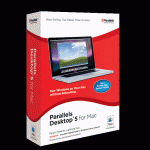Parallels Desktop 5 First Impressions Review

I finally braved the upgrade to Parallels 5 and found it far less painful than I expected. It’s faster, more compatible and generally better than its predecessor and I’d wager most upgraders will see the difference quite soon after taking the plunge.
The upgrade process from 4 was simple enough, requiring no scary disk conversion and, apart from the oft troublesome and slow installation of Parallels Tools, went without troubles.
If you use Parallels 5 to virtualise linux machines then one of the first things you’ll notice, if not the first thing is the immediate presence of desktop effects in a machine first booted within Parallels 5. At least for me this was true of both Ubuntu 9.03 and Ubuntu 9.10.
These improvements show in Windows 7, too, with all of the liberal and oft unbearable gloss of Aero being available from the get-go. But not only is it pretty (to some, at least), it’s fast too- and the improvements to performance in 3D Gaming are quite noticeable. Still, if you plan to play anything recent then you’re going to have to rely on BootCamp. Parallels 5 may deliver a significant improvement in 3D performance, but it’s still no substitute to running Windows on the bare hardware. You can, however, quite comfortably play some excellent classic titles including Dungeon Siege, Half Life and Neverwinter Nights and even, on the appropriate hardware, more recent titles based on the Half-Life 2 engine.
Booting Windows 7 in Parallels 5 on a Core i7 iMac with 8GB RAM is fast. It takes 14 seconds to reach the login screen and thereafter approximately another 14 to log in and get Internet Explorer fired up.
One of my main gripes, at the moment, is that an attempt to boot my Bootcamp Windows 7 partition resulted in a very, very destroyed Windows 7 partition. When fired up, it immediately wanted to do a repair operation which I, stupidly, let it do. Obviously this “repaired” Windows 7 to complete destruction, rendering it unbootable. A quick reinstall solved the problem, but I’m currently staying far away from the Bootcamp install and favouring, instead, a dedicated virtual disk install of Windows 7 solely for Parallels 5.
Over the next month or two, I will be rolling the latest Bootcamp drivers (when they arrive) onto my bare Windows 7 install and attempting to boot it in Parallels 5.
At the moment I’ve also expended two separate keys to activity both the Bootcamp and Parallels 5 version of Windows 7. This isn’t strictly necessary, as Microsoft apparently allow the same key to be used for both virtualization and base-metal installation on the same hardware.
From the get-go I’m quite impressed with Parallels 5 in terms of performance but haven’t really yet given it a run for its money on the gaming front. I plan to do this soon with Steam and will publish the results.
For now, though, rest assured that Parallels 5 is a worthwhile upgrade for existing Linux/Windows XP virtual machines. And is almost essential if you plan to run Windows 7. It’s just a bit of a shame about the upgrade price, I picked up Parallels 4 in Costco for less than it costs to upgrade to 5. Ouch!